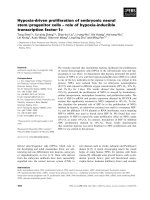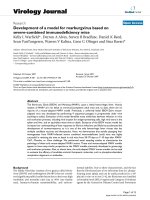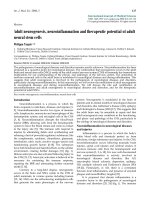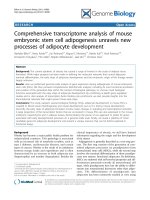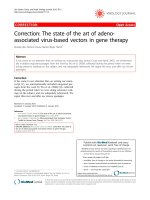Development of new neural stem cell based tumor targeted gene therapy approaches
Bạn đang xem bản rút gọn của tài liệu. Xem và tải ngay bản đầy đủ của tài liệu tại đây (3.49 MB, 148 trang )
DEVELOPMENT OF NEW NEURAL STEM
CELL-BASED TUMOR-TARGETED GENE
THERAPY APPROACHES
ZHU DETU
NATIONAL UNIVERSITY OF SINGAPORE
2012
1
DEVELOPMENT OF NEW NEURAL STEM
CELL-BASED TUMOR-TARGETED GENE
THERAPY APPROACHES
ZHU DETU
(B. Sc.)
A THESIS SUBMITTED
FOR THE DEGREE OF DOCTOR OF PHILOSOPHY
DEPARTMENT OF BIOLOGICAL SCIENCES
NATIONAL UNIVERSITY OF SINGAPORE
&
INSTITUTE OF BIOENGINEERING AND
NANOTECHNOLOGY
2012
2
DECLARATION
I hereby declare that this thesis is my original work and it has been written by me
in its entirety. I have duly acknowledged all the sources of information which have
been used in the thesis.
This thesis has also not been submitted for any degree in any university
previously.
ZHU DETU
21 August 2012
I
ACKNOWLEDGMENTS
I would like to acknowledge all who have helped and inspired me during my study
at the National University of Singapore and Institute of Bioengineering and
Nanotechnology.
I am very grateful to my supervisor, Dr. Wang Shu, Associate Professor,
Department of Biological Sciences, National University of Singapore, for his
invaluable inspiration and guidance during my PhD study.
I would like to dedicate my most sincere gratitude to my parents for their constant
encouragement and support.
I acknowledge the National University of Singapore, for honoring me with
studentship and financial assistance in the form of scholarship.
II
TABLE OF CONTENTS
ACKNOWLEDGMENTS I
TABLE OF CONTENTS III
SUMMARY VI
LIST OF PUBLICATIONS VIII
LIST OF TABLES IX
LIST OF FIGURES X
ABBREVIATIONS XII
CHAPTER 1 INTRODUCTION 1
1.1 Neural stem cells 2
1.1.1 Tumor tropism 2
1.1.2 Cell source 3
1.1.3 Genetic engineering 5
1.1.4 Side effects of intravenous injection 6
1.2 Fusogenic membrane glycoproteins 7
1.2.1 Bystander effect 7
1.2.1.1 Cell fusion 8
1.2.1.2 Antitumor immune response activation 9
1.2.2 Family members 10
1.2.2.1 GALV.fus 10
III
1.2.2.2 Syncytin-1 11
1.2.2.3 VSV-G 12
1.2.3 Applications in tumor gene therapy 12
1.2.3.1 Enhanced antitumor effect 12
1.2.3.2 Difficulties in large-scale clinical application 14
1.3 CD40-CD40 ligand interaction 14
1.3.2 CD40 expression and function in human cells 15
1.3.2 Direct growth inhibition of cancer 18
1.3.3 Antitumor immune response activation 22
1.4. Purpose 26
CHAPTER 2 SELECTIVE KILLING OF CANCER CELLS BY A NOVEL VSV-G
MUTANT THAT PROMOTES LOW PH-DEPENDENT CELL FUSION 28
2.1. Introduction 29
2.2. Materials and Methods 32
2.2.1. Cell culture 32
2.2.2. Mutagenesis, baculovirus preparation and cell transduction 33
2.2.3. Indirect immunofluorescence microscopy 34
2.2.4. Syncytia Formation Assay 35
2.2.5. Cytotoxicity assays 35
2.2.6. Reverse transcriptase polymerase chain reaction 36
2.2.7. Western blot 36
IV
2.2.8. In vitro Boyden chamber cell migration assay 37
2.2.9. Animal studies to evaluate therapeutic efficacy 37
2.2.10. Statistical analysis 38
2.3. Results 40
2.3.1. Whole body biodistribution of intravenously administered NSCs in a
mouse 4T1 breast cancer model 40
2.3.2. Mutagenesis of VSV-G 44
2.3.3. pH-responsive Properties of VSV-G(H162R) 47
2.3.4. In vitro bystander effect of VSV-G(H162R) 53
2.3.5. Establishment of VSVG(H162R)-expressing NSCs using baculovirus
57
2.3.6. Metastatic breast cancer therapy using VSVG(H162R)-expressing
NSCs 62
2.3.7. Side effects of cancer therapy using VSVG(H162R)-expressing NSC
68
2.4. Discussion 70
CHAPTER 3 SELECTIVE KILLING OF CD40-POSITIVE BREAST CANCER
CELLS BY NSC-MEDIATED DELIVERY OF CD40 LIGAND IN A MOUSE
MODEL 75
3.1. Introduction 76
3.2. Materials and Methods 79
V
3.2.1. Cell culture 79
3.2.2. Baculovirus preparation and cell transduction 80
3.2.3. Cytokine antibody array 80
3.2.4. Cytotoxicity assays 81
3.2.5. Reverse transcriptase polymerase chain reaction 82
3.2.6. Fluorescent-activated cell sorting analysis 82
3.2.7. Animal studies to evaluate therapeutic efficacy 83
3.2.8. Statistical analysis 83
3.3. Results 85
3.3.1. Establishment of CD40L-expressing iPS-NSCs using a baculovirus
85
2.3.2. CD40L induces cytokine production in CD40-positive 4T1 breast
cancer cells 87
2.3.3. In vitro bystander effect of CD40L-expressing iPS-NSCs 92
2.3.4. Metastatic breast cancer therapy using CD40L-expressing NSCs 95
2.3.5. Side effects of cancer therapy using CD40L-expressing NSCs 102
3.4. Discussion 104
CHAPTER 4 CONCLUSION 108
References 113
VI
SUMMARY
Neural stem cells (NSCs) have recently emerged as one of the most attractive
cellular vehicles for targeted gene delivery to cancers due to their migratory
capacity and tumor tropism. However, because NSCs can be chemoattracted to
non-target regions, especially after intravenous administration, off-target
transgene expression is a concern for the clinical application of NSC-mediated
cancer gene therapy. To minimize this side effect, therapeutic transgenes that
enable tumor cell-selective killing are needed. In this project, I developed two
novel approaches to target tumor cells.
The first approach uses vesicular stomatitis virus G glycoprotein (VSV-G) to target
tumor acidosis. VSV-G is a viral fusogenic membrane glycoprotein that kills tumor
cells via syncytia formation. Tumor acidosis is one of the hallmarks of the tumor
microenvironment. Here, I have discovered a novel VSV-G mutant that functions
specifically at an acidic tumor extracellular pH, thus enabling VSV-G to selectively
kill tumor cells.
The second approach uses CD40 ligand (CD40L) to target CD40
+
tumor cells.
CD40 is a type I TNF receptor that is selectively expressed on a number of
epithelial and mesenchymal tumors, such as breast tumors, bladder tumors and
lymphomas, but not on most normal, non-proliferating epithelial tissues.
VII
Expression of CD40L in CD40
+
tumors leads to tumor growth inhibition via
apoptosis induction and immunity activation.
In our studies, both approaches showed significant therapeutic effects in vitro and
in vivo. In a mouse model of 4T1 metastatic breast cancer, both VSV-G and
CD40L delivered by NSC-based vectors obtained greater therapeutic efficacy and
reduced less toxicity to normal tissues than the conventional HSVtk/GCV suicide
gene therapy.
These findings are of crucial importance in terms of clinical trials of NSC-mediated
cancer gene therapy. This study is the first to deliver tumor-targeted VSV-G and
cytokine into tumor sites using NSC-based vehicles, and provides a feasible
solution to the current safety issues of intravenously administered NSC.
VIII
LIST OF PUBLICATIONS
Manuscripts
Detu Zhu, Lam Dang Hoang and Shu Wang. Systemic delivery of fusogenic
membrane glycoprotein-expressing neural stem cells to selectively kill tumor cells
through low pH-induced cell fusion. 2012. (submitted to Molecular Therapy)
Detu Zhu, Lam Dang Hoang and Shu Wang. Selective killing of CD40-positive
breast cancer cells by NSC-mediated delivery of CD40 ligand in a mouse model.
2012. (in preparation)
The experiments in the above noted manuscripts were performed during my PhD
study. The major findings were presented in this thesis.
IX
LIST OF TABLES
Table 2.1 Primer pairs used for mutagenesis of VSV-G. 45
Table 2.2 Median survival time and log rank test in the survival study. 67
Table 3.1 Differential expression of cytokines in 4T1 cell cultures after CD40L
treatment. 91
Table 3.2 Statistics of tumor metastasis sites 99
Table 3.3 Median survival time and log rank test in the survival study. 101
X
LIST OF FIGURES
Fig. 2.1 Dual-color, whole-animal imaging to demonstrate the tumor tropism of iPS-NSCs. 42
Fig. 2.2 Dual-color, ex vivo imaging to demonstrate tumor tropism of iPS-NSCs 43
Fig. 2.3 Mutagenesis of VSV-G. 46
Fig. 2.4 Syncytia formation assay between VSVG-expressing iPS-NSCs and 4T1 cells 50
Fig. 2.5 Dual-color syncytia formation assay between VSVG(H162R)-expressing NSCs and 4T1
cells 51
Fig. 2.6 Dual-color syncytia formation assay between VSVG(H162R)-expressing NSCs and
tumors of different lineages 52
Fig. 2.7 Comparison of HSVtk and VSVG(H162R)-mediated cytotoxicity on 4T1 breast cancer
cells. 55
Fig. 2.8 In vitro killing effects of VSVG(H162R) in tumors of different lineages 56
Fig. 2.9 Establishment of VSVG(H162R)-expressing iPS-NSCs using a baculovirus 59
Fig. 2.10 Cell viability assays for BV-transduced iPS-NSCs. 60
Fig. 2.11 Boyden chamber migration assays for BV-transduced NSCs 61
Fig. 2.12 In vivo 4T1 breast cancer therapy using NSC-VSVG and NSC-TK/GCV 64
Fig. 2.13 Bioluminescent images of tumor growth in representative animals 64
Fig. 2.14 Survival analysis. 66
Fig. 2.15 Hepato- and nephro-toxicities of NSC-VSVG or NSC-TK/GCV treatment. 69
Fig. 3.1 Establishment of CD40L-expressing NSC using baculovirus. 86
Fig. 3.2 FACS analysis of CD40 expression on 4T1 breast cancer cell surface 89
XI
Fig. 3.3 Cytokine antibody array. 90
Fig. 3.4 In vitro bystander effect of CD40L-NSCs on 4T1 breast cancer cells 94
Fig. 3.5 In vivo 4T1 breast cancer therapy using NSC-CD40L. 97
Fig. 3.6 Ex vivo organ imaging to demonstrate inhibition of 4T1 tumor metastasis by NSC-40L 98
Fig. 3.7 Survival analysis. 100
Fig. 3.8 Hepato- and nephro-toxicities of NSC-VSVG or NSC-TK/GCV treatment. 103
XII
ABBREVIATIONS
AcMNPV
Autographa californica multiple nucleopolyhedrovirus
ALT
alanine transaminase
AST
aspartate aminotransferase
bFGF
basic fibroblast growth factor
BUN
blood urea nitrogen
BV
baculovirus
CTL
cytotoxic T lymphocyte
CD
cytosine deaminase
CMV
cytomegalovirus
CNS
central nervous system
DC
dendritic cell
DMEM
dulbecco’s modified eagle’s medium
eGFP
enhanced green fluorescent protein
EGF
epidermal growth factor
ESC
embryonic stem cell
FBS
fetal bovine serum
FMG
fusogenic membrane glycoprotein
GALV
gibbon ape leukemia virus
GCV
ganciclovir
GM-CSF
granulocyte-macrophage colony-stimulating factor
HERV-W
human endogenous retrovirus W
HIV-1
human immunodeficiency virus type 1
XIII
HLA
human leukocyte antigen
HSV-1
herpes simplex virus type 1
HSVtk
herpes simplex virus-thymidine kinase
ICAM
intercellular adhesion molecule
IFN
interferon
IL
interleukin
iPSC
induced pluripotent stem cell
LFA
lymphocyte function-associated antigen
Luc
luciferase
mAb
monoclonal antibody
MHC
major histocompatibility complex
MIP
macrophage inflammatory protein
MOI
multiplicity of infection
MV
measles virus
NF-κB
nuclear factor kappa light-chain-enhancer of activated B cells
NK cell
natural killer cell
NSC
neural stem cell
PBS
phosphate buffered saline
PFU
plaque-forming unit
RT-PCR
reverse transcription polymerase chain reaction
SLAM
signaling lymphocytic activation molecule
TAA
tumor-associated antigen
TGF
transforming growth factor
TIL
tumor-infiltrating lymphocytes
XIV
TNF
tumor necrosis factor
TRAF
tumor necrosis factor receptor-associated factor
VSV
vesicular stomatitis virus
5-FC
5-fluorocytosine
XV
CHAPTER 1
INTRODUCTION
1
1.1 Neural stem cells
Neural stem cells (NSCs) are a self-renewing and multipotent population that
gives rise to the three major neural lineages (neurons, astrocytes and
oligodendrocytes) throughout the central nervous system (CNS). NSCs are highly
migratory and display an innate tropic behavior towards neoplastic lesions
(Aboody et al., 2000; Benedetti et al., 2000). Hence, NSCs are promising gene
delivery vectors for tumor-targeted therapy.
1.1.1 Tumor tropism
Metastatic tumors are the most aggressive type of neoplasm in humans,
characterized by a high infiltrative ability and resistance to conventional
therapeutic treatments such as surgical excision, radiotherapy and chemotherapy.
Currently, gene therapy has emerged as a promising new approach for treating
aggressive malignant tumors; however, the low efficiency of transgene delivery
towards tumor sites limits the clinical application of this therapy. To overcome this
barrier, traditional viral vectors, such retrovirus (Rainov and Kramm, 2003; Rainov
and Ren, 2003), adenovirus (Immonen et al., 2004) and herpes simplex virus type
I (HSV-1) (Varghese and Rabkin, 2002) have been extensively explored as gene
delivery vectors. Nevertheless, the use of viral vectors raises several safety
concerns, such as the risk of tumorigenesis caused by viral integration into the
host genome and the wide stimulation of the host immune system. Therefore,
alternative gene delivery vectors are urgently required.
2
Recently, it was reported that transplanted NSCs have a tropism not only toward a
tumor mass, but also toward infiltrative “satellite” tumor cells in animal models
(Aboody et al., 2000; Benedetti et al., 2000; Glass et al., 2005), which makes
NSCs particularly promising for targeted therapies for metastatic tumors.
Furthermore, genetically modified NSCs carrying suicide genes, such as
thymidine kinase (TK) (Benedetti et al., 2000; Li et al., 2005; Uhl et al., 2005) and
cytosine deaminase (CD) (Kim et al., 2006), anti-tumorigenic cytokines (Sims et al.,
2008) or oncolytic viruses (Herrlinger et al., 2000; Tyler et al., 2009) were shown to
exert a strong cytotoxicity toward metastatic tumors via bystander effects.
1.1.2 Cell source
The great potential of NSCs in regenerative medicine highlights the need for
consistent and renewable sources for the collection or production of uniform
human NSCs suitable for clinical applications. Fetal or adult human brain tissues
provide possible sources of primary human NSCs. However, derivation of primary
NSCs from either the adult human brain or from a fetus is an extremely invasive
procedure and raises ethical and regulatory issues. As cell therapy products,
primary human NSCs are variable in quality and hold limited passaging capacity,
posing a significant challenge for the large-scale preparation of cells with stable
characteristics. Although oncogene-mediated immortalization provides a means to
overcome the drawback of limited life span of primary human NSCs, the suitability
3
of therapy application remains questionable due to the well-documented
oncogenic potential of these genes. The ability of human pluripotent stem cells
such as human embryonic stem cells (hESCs) to generate virtually any
differentiated cell type provides the possibility of using these cells as new sources
of human NSCs. Self-renewing hESCs are inherently immortal, and their
proliferation capacity is preserved during long-term cell culture. Hence, they have
become a reliable and accessible source of unlimited amounts of uniform human
stem cells (Zhang et al., 2001; Ben-Hur et al., 2004). However, despite their
unique potential, the use of hESCs remains ethically controversial, because the
process of generating hESC lines involves the destruction of human embryos.
To circumvent this problem, another type of human pluripotent stem cells, human
induced pluripotent stem cells (iPSCs), which are generated through the
reprogramming of adult somatic cells by forced expression of several
transcriptional factors, can be used as a new source of NSCs (Takahashi et al.,
2007; Yu et al., 2007). Standardization of the large-scale mass production of cell
therapeutics is a prerequisite for the widespread application of cell therapy. Thus,
standardization in generating human iPSC-derived cells offers the potential for
manufacturing large batches of uniform, allogeneic cell therapy products that can
be used in a similar way as pharmaceutical products and are sufficient for
repeated treatments in multiple patients. This standardization will help eliminate
variability in the quality of cell therapeutics and facilitate the reliable comparative
4
analysis of clinical outcomes.
1.1.3 Genetic engineering
In recent years, the insect baculovirus has captured great interest as a gene
transfer vector for in vitro and in vivo applications (Hofmann et al., 1995; Kost et al.,
2005; Hu, 2008). The most commonly used baculoviral vectors are derived from
Autographa californica multiple nucleopolyhedrovirus (AcMNPV). This insect DNA
viral vector has proven to be very effective in transducing many mammalian cells
and providing a high level expression of transgenes. The vector has a high cloning
capacity, allowing for the accommodation and delivery of large functional genes or
multiple genes. Unlike many other gene therapy viral vectors, baculoviral vectors
can be produced in serum-free cell culture medium, which eliminates the potential
hazard of serum contamination with viral and prion agents from the donating
animal. An important advantage of using non-human, insect baculoviral vectors as
gene therapy vectors is that it circumvents several inherent problems associated
with using human viral vectors that are currently commonly used, such as the
pre-existing immunity directed against infectious human viruses. For example,
specific antibodies against adenoviruses are detectable in 97% of individuals
(Bessis et al., 2004), which may eliminate viral particles and impair viral
transduction, decreasing both the level and duration of therapeutic gene
expression. Thus, baculoviral vectors are considered novel and promising gene
therapy vectors. In previous studies, baculoviral vectors have been demonstrated
5
to be useful for hESC engineering. It was found that baculoviral vectors effectively
mediate gene transfer to hESCs. Using baculoviral vectors containing eGFP at an
MOI of 100 PFU, up to 80% of the cells in the infected hESC clumps were
eGFP-positive at day 2, as determined using flow cytometry. In a following study,
the baculoviral vectors were reconstructed by including the rep 78/68 genes and
ITR sequences derived from AAV, which enabled them to integrate into the AAVS1
site in the human chromosome 19 and realize stable transgene expression in hES
cells (Zeng et al., 2007).
1.1.4 Side effects of intravenous injection
The systemic intravenous administration of NSCs is an attractive option, given that
intravenous injection is a minimally invasive procedure, and the injected cells may
home in on multiple intracranial tumor foci and solid tumors of a non-neural origin
through the circulation. However, the majority of intravenously injected cells
become trapped in the lung and liver because of the narrow diameters of lung
capillaries and liver sinusoids. In a previous study, it was found that only a small
proportion of NSCs (10%) injected into the systemic circulation could reached the
tumor sites, whereas most of the injected cells were trapped in non-target organs
including the lung, liver and spleen (Yang et al., 2012; Zhao et al., 2012). One of
the safety concerns here is damage to these healthy organs caused by
NSC-delivered cancer therapeutics. As an example, in the HSVtk/GCV system
that employs HSVtk to phosphorylate GCV and interfere with DNA replication in
6
tumor cells, the suicide gene products will eliminate not just cancer cells but also
other proliferating normal cells (Johnson et al., 2005). To avoid the possible side
effects that deteriorate the patient situation, tumor-targeted therapeutic gene is
urgently needed.
1.2 Fusogenic membrane glycoproteins
Fusogenic membrane glycoproteins (FMGs) are a class of glycoproteins derived
from viral envelope genes that can induce cell membrane fusion and cytotoxicity in
mammalian cells. In the year 2000, a research group found that overexpression of
FMGs in tumor cell cultures would induce the formation of gigantic, multinucleated
syncytia that recruited 50-200 cells, thus leading to massive tumor cell death
(Bateman et al., 2000; Diaz et al., 2000; Higuchi et al., 2000). Since then, FMGs
have been extensively explored as antitumor agents.
1.2.1 Bystander effect
Previous studies have demonstrated that FMGs induce strong direct and
bystander killing effects on tumor cells that is at least 10 times greater than those
of conventional suicide gene/prodrug therapies such as herpes simplex virus
thymidine kinase + ganciclovir (HSVtk/GCV) or cytosine deaminase +
5-fluorocytosine (CD/5-FC) (Bateman et al., 2000; Diaz et al., 2000). The powerful
bystander killing effects of FMGs arise from the induction of local syncytia
formation, the activation of antitumor immune response and the spread of
7
pro-apoptotic agents via syncytiosomes.
1.2.1.1 Cell fusion
Overexpression of FMGs in tumor cells leads to massive cell to cell fusion,
formation of gigantic, multinucleated syncytia and subsequent cell death in 2-5
days (Higuchi et al., 2000). The exact mechanism underlying the
syncytia-mediated cell death remains poorly defined, but both necrosis and
apoptosis are involved. In experiments using melanoma models, necrosis
appeared to play a major role in the FMG-mediated syncytia death. In these
studies, it was described that signs of mitochondrial failure, ATP depletion and
autophagic degeneration were observed during the death of syncytia (Bateman et
al., 2002). Indeed, nuclear fusion was also observed, but the nuclei present in the
syncytia could not be stained using the terminal deoxynucleotidyl transferase
dUTP nick-end labeling (TUNEL) assay (Bateman et al., 2000). However, in
experiments using glioma, pancreatic and colorectal cancer models, apoptosis
appeared to play a major role in the FMG-mediated syncytia death. In these
studies, addition of the caspase inhibitor Z-VAD-fmk blocked syncytia death. In
contrast, feeding of fructose to the cultured tumor cells failed to inhibit syncytia
death (Hoffmann et al., 2006; Hoffmann and Wildner, 2006; Hoffmann et al., 2007).
Moreover, the hallmarks of apoptosis were also observed during syncytia death in
the cultured tumor cells, in which 80-90% FMG-mediated syncytia were
TUNEL-positive on day 6 post-transfection (Galanis et al., 2001). Taken together,
8



